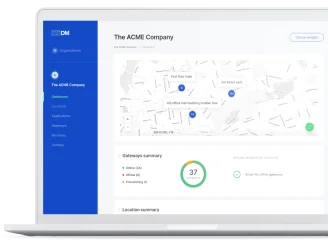Performance testing services
Ensure the stable performance of your IT system under high stress and expected loads.
Maintain infrastructure scalability during peak loads with a performance testing framework
Automate performance testing and regularly implement it
Monitor your system’s performance and generate comprehensive reports
Improve user satisfaction by proactively detecting performance bottlenecks
Audit your software to learn how it handles increasingly high numbers of users, operations, and transactions
Roll out fault-tolerant software solutions
Performance engineering services
High-load system implementation
Capacity planning
Performance evaluation of the cloud environment
Load simulation
Improvement recommendations
Post-implementation re-evaluation
Reporting and visualization
End-to-end performance optimization
Analysis of performance bottlenecks with improvement recommendations
Implementation of best-suited strategies and technology stacks for top performance
Re-evaluation of system performance
All-around performance testing
Load testing
High-volume transaction testing
Varying stress testing
Scalability testing
Endurance testing
Crash testing
End-to-end and custom testing scenarios
System performance monitoring
Visualization of detailed performance statistics via capacity dashboards
Client-side statistics like response time, HPS, and throughput
Server-side statistics like CPU and memory usage, I/O, and network usage
Benefits of Cloud Hawk’ performance testing services
- 01
Enhanced scalability
Define how your system can handle an increasing load to easily fix issues that keep your software from scaling.
- 02
Improved system reliability
Avoid system downtime and unexpected crashes, and keep your system available and reliable all the time.
- 03
Fast time-to-market
Proactively identify software performance issues and speed up development and delivery.
- 04
High user satisfaction
Ensure stable and high-performance software that makes a lasting impression on your users and increases their loyalty to your brand.
- 05
Cost-efficiency
Prevent hasty and costly fixes for software issues that may arise after launch.
Build a reliable and high-performing software system
Implement a fault-tolerant architecture built on the principles of security, scalability, and modularity.
Tools for performance testing and monitoring
Load testing
JMeter
wrk/wrk2
k6
Gatling
Data management
Grafana
InfluxDB
Amazon CloudWatch
Google Cloud Operations
Telegraf
New Relic
Custom performance testing
Load testing scripts
Load emulators
Custom testing scenarios
Post-testing improvements
We use many more tools for performance testing and monitoring than those listed above.
Contact us to learn what else we have to offer.
Software performance testing case studies
Ensure software stability during peak loads
Enhance software quality and system scalability by putting your system through regular automated performance tests.
Some insights into software performance testing and optimization

SaaS application development: challenges, solutions, and benefits
SaaS platform development requires an integrated approach and extensive technical expertise. Learn how to build SaaS software based on Cloud Hawk’ experience.

Monitoring the performance of your Go application: why and how you should do it
In this tutorial, we introduce you a list of the best APM software and on the real example show how to optimize app using collected information.

Cloud migration checklist: 7 steps to successful app migration
In this extensive guide, we unveil the top reasons for cloud migration, touch upon security concerns, and discuss the process of cloud migration step-by-step.
What sets your software performance testing services apart from those of other providers?
For every project, we involve industry-specific experts who can make valuable contributions or offer a unique perspective. Our team also adheres to a holistic software development approach by designing defect-tolerant architectures that are scalable and secure by design. Plus, to deliver all-around software performance testing services, we focus on automation, using open-source tools for performing quick and regular testing.
To make the most of performance testing, we develop reports that highlight key metrics and patterns necessary for monitoring software performance optimization over time. Cloud Hawk is a go-to provider of performance testing services in the USA. By choosing our services, you gain access to deep technical expertise and guarantee yourself an on-demand testing team that supports your application’s performance even after the release.
What metrics do you measure during software performance testing?
As an accredited quality assurance company, we focus on key metrics for software performance testing, including response time, error rate, throughput, bandwidth, and resource utilization. Response time helps us identify how quickly a system responds to users’ requests or actions. It’s a critical parameter of system performance. If software processes users’ requests too slowly, users will likely stop using the application or website.
The throughput metric indicates how many requests or transactions the system can process over a certain period of time, and bandwidth shows the volume of data transferred through the system over a certain period. The error rate, in turn, shows whether the system is stable and reliable, and resource utilization provides insights on CPU and memory consumption. Depending on your needs and project requirements, we select metrics that help you thoroughly evaluate how your system performs.
Do your software performance testing services include an approach to analyzing performance testing results?
After completing load and performance testing, we collect the results in reports to define correlations among metrics and work on an action plan for improving system or app performance or eliminating issues or bottlenecks. For instance, we can apply a scaling strategy if an app isn’t able to handle expected growth in the number of users or data volume.
If the system can’t meet increased demand, we use additional servers, increase the power of existing servers, or use load balancers. After this, we analyze the system’s behavior, strengths, and weaknesses. Analyzing load and performance testing results can also provide hints on how to improve the user experience of your software solution or which architectural interventions can be done to improve the system’s performance.
How do you develop a software performance testing framework, and which use cases benefit from it the most?
A software performance framework is the next level of performance testing solutions. It requires thorough preparation to set up a testing environment, establish workload modeling, and implement test automation services, techniques, and practices to ensure a regular and highly efficient performance testing service.
We can help you build a custom performance testing framework that will seamlessly work for your system, enabling regular test runs with prompt documentation and reports that will help your system stay scalable and stable for as long as needed. Practically any project can benefit from a testing framework. But if your project is a simple MVP solution, then implementing a framework may be optional or even unnecessary. For complex and large systems with multiple user roles, however, it’s the best-fit option that can allow you to quickly monitor and modify system performance.
Cloud Hawk’ approach to software performance testing with technology examples
Load and performance testing services involve several approaches and tools. Which approach and set of testing tools to choose depends on your project requirements. A quality assurance specialist at Cloud Hawk takes the following steps to conduct performance testing:
1. Planning scenarios for performance tests
Providing effective software testing services requires deliberate planning. During the first phase of project planning, the business analyst collects non-functional requirements against which performance metrics will be checked. Based on these requirements, we prepare a test script and one or more test scenarios.
As a result of planning, our specialists decide on the relevant testing approach and its components. For instance, load performance testing can be conducted using two approaches. The first is longevity testing, which checks if a system can withstand a constant moderate workload for a long time. The second approach is volume testing, which subjects a system to a high workload for a limited time. Both of these load and performance testing approaches help us to identify and resolve performance bottlenecks, bugs, and component limitations.
2. Choosing optimal technologies
For effective software performance testing services, we need to opt for technologies and tools that will be well-suited for the particular testing project. For instance, during load testing, we often make use of such tools as Gatling and Apache JMeter.
Gatling helps us quickly create different software performance testing scenarios. As the script runs, Gatling makes an informative HTML report showing the response time of each request.
Apache JMeter is a load testing tool with a graphical user interface (GUI) mode that enables our specialists to make test plans manually, select from templates, or record the app under test from a browser session. Additionally, GUI mode provides debugging and the ability to look through test results. If we have a ready test plan, we use the non-GUI mode to run tests from the command line. JMeter can save test results to an HTML, CSV, or XML file.
3. Conducting software performance testing
To begin performance testing, our QA specialists set the number of requests to send, the test script, and the time to perform the test. Each request then targets the system for a fixed period as the automated testing tool notes the performance.
While conducting software performance testing, we make performance metrics correspond to non-functional requirements collected during the discovery stage. We also apply the correlation method to identify which responses from the server are dynamic (able to return different data for each request, which periodically influences subsequent requests) and which are static (don’t change). Correlation is essential to handle dynamic content and can be omitted only when testing pages with static content, such as some home pages.
Software testing results in the discovery of bottlenecks and a list of possible system improvements. Then comes the actual software performance optimization, with infrastructure changes and architecture updates if necessary.
Types of load and performance testing at Cloud Hawk
We conduct a wide selection of software testing services such as:
Load testing. This type of performance testing defines system behavior under normal and peak loads. During load testing, we simulate a large number of simultaneous users to check how the system responds. Load performance testing helps us define how the system handles high loads and come up with an improvement strategy if any issues occur. Load testing metrics include throughput rate and response time.
Stress testing. This checks how the system reacts to extremely high and unexpected loads. Stress testing is important for evaluating a system’s reliability and increasing its stability by observing how quickly the system recovers after exceeding its limits. The typical stress testing metric is error rate.
Volume testing. This is another of our performance testing services. Volume software testing transfers a large amount of data through the system to define how it behaves when confronted with large data sets. Conducting volume testing helps us define how the database responds and ensure that the system can process large amounts of data without significant performance issues.
Scalability testing. This type of performance testing assesses how the system handles an increasing load. QA specialists can use it to define the system’s potential to scale without compromising system performance.
Endurance testing. This type of software testing helps us analyze how long the system can handle high loads. By eliminating issues that arise as a result of this software performance testing, we can increase system resilience and make the system reliable over a long time period.
Spike testing. To enable this testing, we put the system through sudden spikes of increased user load and evaluate how it responds. Spike testing helps us define how to ensure system stability under sudden surges in user demand.
Comparative testing. This type of software performance testing involves checking the performance of different software solutions or different versions of a single solution to compare metrics and determine which solutions or versions perform better and why.
Cloud Hawk performance testing services can help your software system be reliable, remain stable, and scale along with your business growth.
Collaborate with Cloud Hawk
Message sent successfully!
Cloud Hawk in brief
- 6+
years of experience
- 500+
IT experts aboard
- 35+
active clients
Project inquiries
Careers
Phone number
+44 788 4809964
Our offices

UAE
Al.khaleej building Deira Dubai
UK
SO140DB Southampton, United Kingdom

















